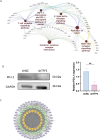Inhibition of TFF3 improves the infiltration and function of CD8+ T cells by downregulating the expression of PD-L1 in colorectal cancer
- PMID: 40762831
- PMCID: PMC12325462
- DOI: 10.1007/s00384-025-04964-0
Inhibition of TFF3 improves the infiltration and function of CD8+ T cells by downregulating the expression of PD-L1 in colorectal cancer
Abstract
Background: Colorectal cancer is a common malignant tumor of the digestive tract with a high mortality rate. TFF3 is a secreted protein expressed in various cancers. The aim of the study is to report that inhibiting TFF3 increases the function and infiltration of CD8+ T cells in colorectal tumor tissues.
Methods: The proteomics analysis confirmed the high expression of secreted TFF3 in the supernatant of colorectal cancer cells, and databases were used to analyze the immune infiltration in tumor tissues. qPCR test was used to demonstrate the high levels of secreted TFF3 affecting the function of CD8+ T cells. In vivo experiments were used to observe the effects of TFF3 knockdown on tumor growth and immune cell infiltration. Tumor-infiltrating T lymphocytes were sorted for RNA sequencing and mechanism explanation.
Results: Inhibiting the expression of TFF3 in tumor tissues improved immune cell infiltration and enhanced anti-tumor effects. TFF3 knockdown downregulated the expression of PD-L1 in tumor tissues through the AKT/mTOR pathway, which enhanced the function of CD8+ T cells.
Conclusion: Knockdown of TFF3 improved the infiltration of CD8+ T cells and anti-tumor capabilities.
Keywords: Immune infiltration; PD-L1; TFF3.
© 2025. The Author(s).
Conflict of interest statement
Declarations. Competing interests: The authors declare no competing interests.
Figures






References
-
- Biller LH, Schrag D (2021) Diagnosis and treatment of metastatic colorectal cancer: a review. JAMA 325(7):669–685 - PubMed
-
- Guo H, Tan YQ, Huang X et al (2023) Small molecule inhibition of TFF3 overcomes tamoxifen resistance and enhances taxane efficacy in ER+ mammary carcinoma. Cancer Lett 579:216443 - PubMed
-
- Yio X, Zhang JY, Babyatsky M et al (2005) Trefoil factor family-3 is associated with aggressive behavior of colon cancer cells. Clin Exp Metastasis 22(2):157–165 - PubMed
MeSH terms
Substances
Grants and funding
LinkOut - more resources
Full Text Sources
Medical
Research Materials
Miscellaneous

